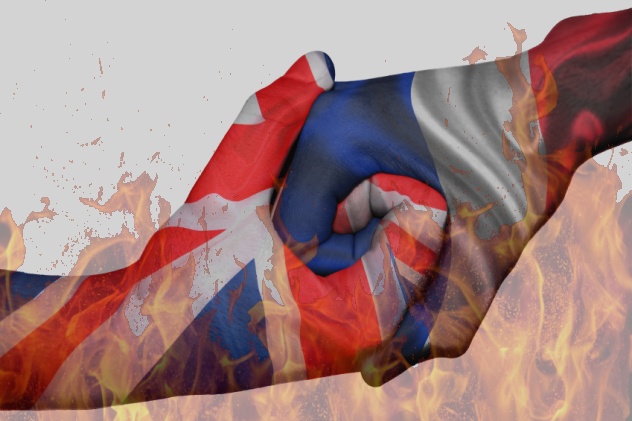 Weird Stuff
Weird Stuff  Weird Stuff
Weird Stuff  Miscellaneous
Miscellaneous 10 Things You May Not Know About the London Underground
 Books
Books 10 Great Literary Works That Almost Had Terrible Titles
 History
History 10 World Events That Made the News a Century Ago in 1925
 History
History 10 Sobering Submarine Incidents from the 1960s
 Miscellaneous
Miscellaneous 10 Words That Don’t Mean What You Think They Mean
 Space
Space Ten Mind-Bending Ideas About Black Holes
 Movies and TV
Movies and TV 10 of the Most Generation Defining Films
 Our World
Our World 10 Anomalous Fossil Finds That Stumped Scientists
 Weird Stuff
Weird Stuff 10 Amusing Tales of Lost and Stolen Celebrity Items
 Weird Stuff
Weird Stuff 10 Strange Traditions and Rituals on Transatlantic Ships
 Miscellaneous
Miscellaneous 10 Things You May Not Know About the London Underground
 Books
Books 10 Great Literary Works That Almost Had Terrible Titles
Who's Behind Listverse?

Jamie Frater
Head Editor
Jamie founded Listverse due to an insatiable desire to share fascinating, obscure, and bizarre facts. He has been a guest speaker on numerous national radio and television stations and is a five time published author.
More About Us History
History 10 World Events That Made the News a Century Ago in 1925
 History
History 10 Sobering Submarine Incidents from the 1960s
 Miscellaneous
Miscellaneous 10 Words That Don’t Mean What You Think They Mean
 Space
Space Ten Mind-Bending Ideas About Black Holes
 Movies and TV
Movies and TV 10 of the Most Generation Defining Films
 Our World
Our World 10 Anomalous Fossil Finds That Stumped Scientists
 Weird Stuff
Weird Stuff 10 Amusing Tales of Lost and Stolen Celebrity Items
10 Etymological Origins Of Ethnic Slurs
Human beings like to divide themselves into different categories, a process that began with family units and tribes and eventually worked its way up to nationalities, races, ethnicities, and vaguely defined civilization groups. Another aspect of humanity is its natural tendency toward creativity. It was perhaps unavoidable that we’d spend so much time and effort coming up with nasty words to call each other.
10 ‘Cracker’

Many assume that the term “cracker” originated from Southern slave owners (who cracked their whips), but the truth is more complicated. It was used in the United States in the 18th century to refer to poor whites living in Maryland, Virginia, and Georgia, who often made their living driving livestock using a whip. However, over time, the term “cracker” came to be used by upper-class whites to refer to the indigent, criminals, or those of Scots-Irish descent in general. The first use of the term can actually be traced back to the 16th century, when it denoted an obnoxious blowhard. It was used by Shakespeare in his King John: “What craker is this same that deafs our ears with this abundance of superfluous breath?”
This expression apparently made its way to the New World to describe a certain class of people, which a 1766 letter described as “great boasters [and] a lawless set of rascals on the frontiers of Virginia, Maryland, the Carolinas and Georgia, who often change their place of abode.” It was generally used to describe Scots-Irish immigrants perceived to be unruly. One Florida governor is said to have complained: “We don’t know what to do with these crackers—we tell them to settle this area and they don’t; we tell them not to settle this area and they do.”
In the late 1800s, people in the North began to refer to Southern homesteaders as “crackers,” referencing slavery although few of the descendants of the original “crackers” would have owned slaves at the time. However, by that stage, the descendants of Scots-Irish immigrants had begun to take on the term as a self-identifier, linking it with distinctive cultural, culinary, and architectural characteristics. Georgia itself became known as the “Cracker State.” It wasn’t until the 1940s that the term began to be used to describe bigoted whites in general. It may have been brought and popularized by African-Americans moving into the North and West during the Great Migration.
9 ‘Kaffir’

Most commonly used as a pejorative term in South African English, the word “kaffir” originates from the Arabic term qafr, meaning “nonbeliever.” It was used by Arab merchants in Africa and India to describe non-Muslim locals. It derived from the word kafara (“to cover”), with the implication that non-Muslim Africans were covering up or obscuring the truth of a monotheistic deity. The term was a fair bit stronger than the English word “pagan,” as it could be translated as “concealer” or “denier” and suggested someone who willfully disbelieved despite all evidence to the contrary.
While the Arabic term could be applied to any nonbeliever regardless of race, later Portuguese explorers, slavers, and merchants operating on the East African coast began to use it to refer to all black Africans, though they spelled it cafre. This spread to other colonial powers, where it was adopted in South Africa as a pejorative word for black people. Some later began to use the term specifically to describe the Xhosa people south of the Natal region. By the 20th century it was considered a general pejorative. “Kaffir” was also used in India to describe the hill tribes of the northwestern frontier.
Though this etymology is well-accepted, not everyone was convinced. South African satirist Herman Charles Bosman was one such rebel, although his reasoning is problematic in itself: “The etymologists’ tame derivation of the word ‘kaffir’ from the Arabic for ‘unbeliever’ must be rejected by anybody with a feeling for the significance of words. It is a strong, florid word, broad as the African veld, and in its disyllabic vehemence is a depth of contumely that I am sure no Arab would ever be able to think up.”
8 ‘Kike’

The common 20th-century pejorative word for Jews entered American English as early as 1914 in New York but would not appear in the Oxford dictionary until 1961. Prior to that, “kike” was only listed as an alternative spelling for the Scottish/Northern English dialect word “kick” or “keek,” meaning “to peep” or “to glance.”
The pejorative “kike” clearly has its origins stateside, and it likely actually originates from Yiddish. One early explanation was that the term was used by German Jews, who had assimilated into US culture, to describe more recent Jewish immigrants from Eastern Europe. Many Ashkenazic names ended in “-ski” or “-sky,” and the theory goes that they were taunted by being called “ki-ki,” which eventually became “kike” and was applied to Jews in general by anti-Semites. This theory was advanced by the linguist J.H.A. Lacher, who claimed to have heard it from Jews “of German origin, who soon insisted that the business ethics and the standard of living and culture of these Russians were far lower than theirs.”
Another theory, perhaps more plausible, suggests that Eastern European Jewish immigrants arriving at Ellis Island were often illiterate or at least unlettered in the Latin alphabet. They couldn’t sign their names on immigration documents and had to make a mark instead. Rather than signing with an “X,” associated with Christianity and the brutal Roman mode of execution, they signed with a circle “O,” called a kikel or kikeleh (“little circle”) in Yiddish.
Jewish storekeepers on the Lower East Side and Jewish traveling salesmen in the interior of the US, who both depended on credit for their trade, would also check off payments in account books with such circles. Soon, both immigration inspectors and Midwestern sales customers were referring to Jews as “kikes,” and this spread to the rest of the population. The Yiddish origins were quickly forgotten.
7 Jjanggae And Gaoli Bangzi

A common Korean pejorative term for Chinese people is jjanggae, which is generally translated into English as “chink.” It is often used casually to refer to citizens of China, Taiwan, Koreans of Chinese descent, and even Chinese or Korean-Chinese food. The term has its origins in the Chinese word zhanggui, which means “shopkeeper” but is considered an archaic expression (like the English “barkeep,” meaning “bartender”). Supposedly, Korean customers at restaurants in China would hear employees referring to the boss as zhanggui, which became the basis for the Korean term jjanggae and developed a pejorative edge over time. It may also have referred to boxes used by Chinese merchants to collect money during the Japanese colonial era.
The Chinese in turn refer to Koreans as gaoli bangzi, which the New York Times translated as “Korean hicks.” Gaoli is a reference to the ancient Korean kingdom of Goryeo, which existed between the 10th and 14th centuries and was allied with the Tang dynasty. Bangzi literally means “stick” and is apparently a reference to the Japanese occupation of Manchuria and the Shandong peninsula. While the Japanese police had guns, Korean police working for the Japanese were supposedly only given batons, which were used to beat Chinese people. This may also have been linked to older history, which states that when the Sui dynasty invaded the Goryeo kingdom during the Middle Ages, the Koreans defended themselves with sticks. Others say that the expression emerged from the idea that Korean immigrants to China were used by the Japanese as a figurative baton as a way to keep Chinese people in line during the occupation period.
6 Farang

Many people visiting Thailand assume that farang is a slur, though it is generally not used as such. Many foreign residents of the country believe it to be pejorative, insisting on more neutral terms like khon tang chat or khon tang prathet, meaning “foreigner” or literally “different country person.” While Thais insist that farang is a neutral term in and of itself, some claim that it’s almost always used negatively. The ultimate meaning could arguably be understood as “barbarian,” though it’s used casually by most Thais to describe Western foreigners.
There are a number of folk etymologies relating to the term. Some believe it comes from farangseet, the Thai word for the French, but farang predates the arrival of Europeans in Southeast Asia. In fact, the word more likely came from the Arabic firinjia, used to refer first to the Franks and then Western Europeans in general during the Crusades. Different versions of this word spread through trade to languages as far removed as Greek (frangos, firanja) and Vietnamese (pha-rang, pha-lang-xa).
It was first used in Thailand to refer to the Portuguese but was then applied to Western Europeans in general. It is also the word for “guava,” which was introduced from the Americas by the Portuguese, though it was likely originally known as kluai farang (“Frankish banana”). Farang turns up in other food items as well, such as “potato” (man farang or “Frankish tuber”), “asparagus” (naw maai farang or “Frankish bamboo shoots”), and “parsley” (phak chii farang or “Frankish cilantro”).
5 Rosbifs And ‘Frogs’

The traditional rivalry between England and France created the strange offensive terms that the two countries used for each other, les rosbifs and “the frogs.” Initially, rosbif referred to the English method of cooking roast beef. As linguistics expert Professor Richard Coates from Sussex University told the BBC, “Rosbifs became a mark of the Englishman as far as the French were concerned in the 18th century, simply because it was a very popular way of cooking. That style began to apply to other meats cooked in the same way, so you would also have ‘rosbif de mouton’ and that sort of thing.” By the 1850s, however, the expression was being used to describe the Englishmen themselves, though it was generally seen as reasonably inoffensive.
The Francophobic expression “frog” may appear to derive from eating frog legs, but it is actually an older insult that was first applied to the Jesuits and the Dutch, who were compared to frogs because they were “marsh-dwellers.” It was only after 1805 that the term became applied to the French, who were considered a national enemy at the time. This was likely reinforced by Gallic frog leg–eating as well as the fleur-de-lis (the French national symbol) being described by some as three frogs or toads saluting.
4 Terrone

The Italian slur terrone is derived from terra (“earth”) and is generally used by Northern Italians to refer to both Southern Italians and African immigrants. The term literally means “people of dirt” or “the dirt beneath one’s feet” and became popularized during the 1950s and 1960s as Northern Italy went through rapid industrialization, and many Southerners moved north to find work in the cities. According to Gregory Pell, the term “implies backwardness and primitiveness . . . it alludes to a notion of the South being a third-world culture, as compared to the first-world industrial society of northern Italy.”
Later, when African immigrants arrived in Italy, the term was also applied to them, a process no doubt encouraged by the fact that many newcomers took on agricultural jobs in the South. This coincided with popular far-right notions of Northern Italians being descended from “industrious” Celts, as opposed to “lazy and agrarian” Mediterraneans in the South, associated with the ancient Greeks and Etruscans. Southern Italians and Africans were conflated into an inferior and subhuman “other” by Northern supremacists. Indeed, one of the terms used by Northern Italians to refer to Southern Italians is africani. However, new slurs specific to immigrants have also emerged, such as marocchini, denoting both Arabs and sub-Saharan Africans, as well as sottoterrone, meaning “sub-dirt beneath one’s feet.”
3 ‘Wop’

This term, used chiefly in the United States to refer to people of Italian descent, has a number of false etymologies being bandied about on the Internet claiming that it derives from “Without Papers” or “Without Passport.” Supposedly, immigration officials at Ellis Island used stamps, chalk, or placards to designate those arrivals lacking sufficient documents as “WOP.” However, the association with immigration documents makes little sense, as the term has been recorded since 1908, while immigration papers weren’t required until 1918.
“Wop” actually derived from the Sicilian and Neapolitan slang term guappo, which means “thug” or “gangster.” Guappo may have come from the Spanish adjective guapo (“bold”) during the period of Spanish rule over Southern Italy. The Spanish term was itself derived from the Latin vappa, meaning “sour wine,” which the Romans used to describe a worthless person or loser.
Southern Italian immigrants to the US used guappo among themselves, and it only acquired an offensive meaning when it was picked up by other Americans and mutated into “wop.” By the 1890s, it was being applied to Italians in general as well as restaurants (“wop-house”), spaghetti (“wop-special”), and Italy (“Wopland”). It may have been popularized throughout the English-speaking world by early talkie films and was in wide use in English-language newspapers during World War II.
2 Pindos

This Russian term is used to refer to Americans, known by the pluralized form pindoses, while the United States itself can be referred to as “Pindostan” or “Pindosia.” It is commonly used on the Russian Internet to refer to disliked US companies or politicians. In Russian, the etymology is not entirely clear. It was first used to refer to a kind of pony found in the Pindos Mountains in Greece. By the 19th century, it was used by Russians to refer to Azov and Black Sea Greeks.
The word had various meanings in the 20th century, describing homosexuals or black people or being used as a general term of disparagement by members of the military. Some say that the term originates from the Spanish word pendejo (“idiot”). However, the most popular etymology states that it was introduced to the Russian language through Serbian. During the Kosovo War, the Serbs believed that US peacekeepers, who were loaded with heavy equipment, resembled penguins, and the British became known as half-penguins. Russian soldiers are supposed to have picked the word up from the Serbs and popularized it back home.
The only problem with that etymology is that the Serbian word for penguin isn’t pindos, but rather pingvan. Perhaps the truth is closer to speculation in The Moscow Times: “It seems like it was a word in search of a definition. It has richly obscene, vaguely comical and highly derogatory sound associations.”
1 ‘Foreign Devil’

Early in Chinese history, foreigners were generally known by two terms—fan or yi. Following the Opium Wars (which were known in China as the “Yi Peril”), xenophobic sentiment saw the rise of the term yangguizi (“foreign devils”) to describe Westerners. Carl Crow, an American businessman who worked in China in the early 20th century, claimed that it was because, “With their red faces, protruding eyes, and absurdly complicated and uncomfortable clothing, all foreigners had the appearance of devils.”
Gui, meaning “devil,” was a term with a deeply negative connotation, and during early encounters with European explorers, the Chinese perceived many aspects of the Western physical form, such as deep-set eyes, long noses, narrow mouths, overall paleness, and bizarre hair color, as being reminiscent of monsters of ancient Chinese myth. The term was popularized as a weapon of political rhetoric following the Opium Wars and was commonly used between the 1840s and the 1940s.
During the Boxer Uprising, a political declaration called the “Sacred Fist” was posted, stating:
The devil’s eyes were blue . . . Wiping them out is a breeze . . . France is desolate, and Britain and Russia in despair . . . The foreign devils are at the end of their tether . . . The Great Qing Empire will rule the land.
Gui was later applied to foreigners in various ways, such as to foreign diplomats (“devil-diplomats”) as well as currency bearing the heads of foreign monarchs (“devil heads”).
In mainland China, yangguizi was replaced by more neutral terms like waiguoren (“foreign person”) or laowai, (“old foreign”), which has a positive association in China. In Hong Kong, the expression gweilo (usually translated as “ghost man” though deriving from the same Chinese characters as guizi) is still widely used, though the government has been reducing their use through anti-racism legislation.
In Singapore, the equivalent expression was the Hokkian term ang mo kwuy, which means “red-haired devil” and was used to describe Caucasians. More recently, this has been commonly shortened to simply ang mo (“red-haired”), which is less obviously offensive. It may have been the inspiration for Singapore’s Ang Mo Kio district, which can be translated as “Caucasian Bridge” or “Red-Haired Bridge.”
David Tormsen is sad there wasn’t enough information online to include ‘seppo’ in this list. Email him at [email protected].








